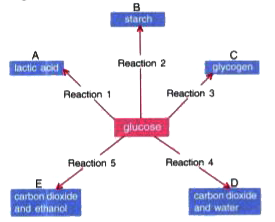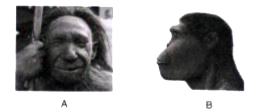Give one example for each of the following
I. Eurythermal plant species……..
II. A hot water spring organism…………
III. An organism seen in deep ocean trenches……….
IV. An organism seen in compost pit…………
V. A parasitic angiosperm.............
VI. A stenothermal plant species...............
VII. Soil organism............
VIII. A benthic animal..........
IX. Antifreeze compound seen in antarctic fish.............
Step-by-Step Text Solution:
1. Eurythermal Plant Species:
- Eurythermal plants are those that can tolerate a wide range of temperatures.
- Example: Red algae (e.g., *Porphyra*).
2. Hot Water Spring Organism:
- Organisms that thrive in high-temperature environments, such as hot springs, are known as thermophiles.
- Example: *Thermus aquaticus*.
3. Organism Seen in Deep Ocean Trenches:
- Deep ocean trenches are extreme environments where specialized organisms can survive.
- Example: Sea cucumbers (e.g., *Holothuroidea*).
4. Organism Seen in Compost Pit:
- Compost pits are rich in organic matter and host various decomposers.
- Example: Earthworm (e.g., *Lumbricus terrestris*).
5. Parasitic Angiosperm:
- Parasitic angiosperms derive nutrients from their host plants.
- Example: *Cuscuta reflexa* (also known as dodder).
6. Stenothermal Plant Species:
- Stenothermal plants can only tolerate a narrow range of temperatures.
- Example: Conifers (e.g., *Pinus* species) found in colder, mountainous regions.
7. Soil Organism:
- Soil organisms play a crucial role in nutrient cycling and soil health.
- Example: Earthworm (e.g., *Eisenia fetida*).
8. Benthic Animal:
- Benthic animals live on or near the bottom of water bodies.
- Example: Crabs (e.g., *Brachyura*) or sponges (e.g., *Porifera*).
9. Antifreeze Compound Seen in Antarctic Fish:
- Antarctic fish have developed adaptations to survive in freezing temperatures.
- Example: Antifreeze glycoprotein, which prevents their blood from freezing.
- Eurythermal plants are those that can tolerate a wide range of temperatures.
- Example: Red algae (e.g., *Porphyra*).
- Organisms that thrive in high-temperature environments, such as hot springs, are known as thermophiles.
- Example: *Thermus aquaticus*.
- Deep ocean trenches are extreme environments where specialized organisms can survive.
- Example: Sea cucumbers (e.g., *Holothuroidea*).
- Compost pits are rich in organic matter and host various decomposers.
- Example: Earthworm (e.g., *Lumbricus terrestris*).
- Parasitic angiosperms derive nutrients from their host plants.
- Example: *Cuscuta reflexa* (also known as dodder).
- Stenothermal plants can only tolerate a narrow range of temperatures.
- Example: Conifers (e.g., *Pinus* species) found in colder, mountainous regions.
- Soil organisms play a crucial role in nutrient cycling and soil health.
- Example: Earthworm (e.g., *Eisenia fetida*).
- Benthic animals live on or near the bottom of water bodies.
- Example: Crabs (e.g., *Brachyura*) or sponges (e.g., *Porifera*).
- Antarctic fish have developed adaptations to survive in freezing temperatures.
- Example: Antifreeze glycoprotein, which prevents their blood from freezing.
Topper's Solved these Questions
- ORGANISMS AND POPULATIONSBook:NCERT EXEMPLAR ENGLISHChapter:ORGANISMS AND POPULATIONSExercise:Short Answer Type Questions
Explore 17 Videos
- MOLECULAR BASIS INHERITANCE Book:NCERT EXEMPLAR ENGLISHChapter:MOLECULAR BASIS INHERITANCE Exercise:Long Answer Type Questions
Explore 9 Videos
- PRINCIPLE OF INHERITANCE AND VARIATIONS Book:NCERT EXEMPLAR ENGLISHChapter:PRINCIPLE OF INHERITANCE AND VARIATIONS Exercise:LONG ANSWER TYPE QUESTIONS
Explore 5 Videos
Similar Questions
Given below are chemical reactions (1 to 5) involving glucose and five other chemical products (A-E).

(a) Write the reaction number of the following:
(i) Anaerobic respiration in plants .........
(ii) End-products in aerobic respiration ...........
(iii) Reaction occurring in liver ............
(iv) Anaerobic respiration in animals ................
(v) Storage in the liver..............
(b) Which reactions (1-5) in the above correspond to the following (write the corresponding number of reaction next to them).
(i) Aerobic respiration
(ii) Change taking place in the liver
(iii) Anerobic respiration in yeast.
(iv) Change taking place in a plant storage organ, e.g., potato.
(v) Anaerobic respiration in animals
View SolutionFill in the blanks for the statement given below.
i. Collection of actual specimens of plant / animal species is essential and the prime source of........a..........
ii.presence of notochord and dorsal hollow neural system are features of ...........b..........
iii. Stuffed and preserved terms are associated with ..........c.....
iv. .....d........... represents the choice made between two opposite options.
V. The number and type of organism present on earth known as .......e.........
View SolutionStudy the following statements and select the correct ones.
i) Organisms restricted to a narrow range of temperatures are called eurythermal.
ii) Organisms capable of tolerating a wide range of temperature are called stenothermal organisms.
iii) The levels of thermal tolerance of different species determine to a large extent their geographical disrributio.
iv) Temperature affects the kinetics of enzymes.
View SolutionWhich of the following statement/s is/ are WRONG ?
I. Mammals from colder climates generally have shorter ears and limbs to minimise heat loss.
II. The UV component of the spectrum is harmful to many organisms.
III. The tiger census in our national parks and tiger reserves is often based on actual headcounts.
IV. Some desert plants like Opuntia,have no leaves - they are reduced to spines.
V. In brood parasitism , the parasitic bird lays its eggs in the nest of its host and does not allow the nest incubate them.
View SolutionState whether the following compounds are inorganic or organic :
(i) caustic soda (ii) sugar
(iii) nitric acid (iv) blue vitriol
(v) vegetable ghee (vi) mustard oil (vii) baking soda.
View SolutionHow many of the following statements are not correct?
[I] In a flowering plant the substances that would need to be transported are water, mineral nutrients, organic nutrients and plant growth regulators.
[II] Over small distances, substances move by diffusion and by cytoplasmic streaming supplemented only by passive transport.
[III] Organic and mineral nutrients undergo multidirectional transport through the xylem.
[IV] From the storage organs, organic compounds are later re-exported.
[V] Phytohormones and other chemical signals are transported to maintain and regulate the plant functions.
View SolutionConsider the following features seen in a plant:
I: Male and female reproductive organs are generally found in separate flowers.
II: The male flowers having a number of long filaments terminating in exposed stamens.
III: The female flowers having long feather-like stigmas.
The flowers of this plant would most likely be pollinated by:
View SolutionHow many of the following statements (s) are correct ?
(i) Genus comprises a group of related species which has more characters in common in comparison to species of other genera .
(ii) 'pardus' and 'leo' are two different species but both belong to the genus Felis.
(iii) Each genus may have one or more than one specific epithets representing different organisms .
(iv) A species is a group of individuals with highest fundamental similarities and maximum number of organisms.
View SolutionName the type of interaction seen in each of the following examples (i) Ascaris worms living in the intestine of human
(ii) Wasp pollinating fig inflorescence.
(iii) Clown fish living among the tentacles of sea-anemone
(iv) Mycorrhizae living on the roots of higher plants
(v) OPCh-id growing on a branch of a mango tree
(vi) Disappearance of smaller barnacles when Balanus dominated in the Coast of Scotland.
View SolutionGiven below are two stages in the evolution of man. Study them and answer the questions that follow :

(i) Identify Australopithecus and Neanderthal man from the above pictures.
(ii) Mention two characteristic features each for the two stages.
(iii) Who proposed the theory of Natural Selection?
(iv) Name the organism used as an example to explain 'Industrial Melanisum'.
(v) Give two examples of Vestigial organs in humans.
View Solution

